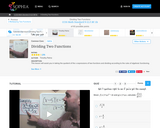
In this tutorial students will learn how to interpret weather maps and understand weather forecasting.
- Subject:
- Earth Science
- Science
- Material Type:
- Presentation
- Provider:
- Sophia
- Author:
- Janelle Wilson
- Date Added:
- 02/26/2019

In this tutorial students will learn how to interpret weather maps and understand weather forecasting.

In this tutorial students will investigate different types of weather phenomena (lightning, tornadoes, hurricanes, blizzards and floods). Students will also relate unequal heating of land and water surfaces to form large global wind systems and weather events such as tornados and thunderstorms

In this tutorial students will learn about the effects of human activity on the erosion of Earth’s surface.

This lesson defines the Substitution Property of Equality.

In this lesson, students will use the Demographic Transition Model (DTM), Rostow’s Economic Development Theory and Wallenstein’s Three–Tier World System’s Theory to take a closer look at four countries in the world. Students will use the CIA World Fact book to research economic indicators, as well as Nation Master to research population pyramids and find correlations between them. Students will also compare the challenges and benefits of two countries that are at two different stages of the DTM.

This video helps students determine whether a given value is a solution to a given linear equation in one variable or linear inequality in one variable.

This lesson explains how simple quantities can change depending on the frame of reference.

This lesson will assist you in taking the quotient of the x expressions of two functions and dividing according to the rules of algebraic functioning.

This lesson will provide real world examples that involve setting up and solving for an exponential decay problem.

This lesson will provide real world examples that involve setting up and solving for an exponential growth problem.

This lesson will show you how to use the proper formula and rewrite an equation as a logarithm and then again as an expression with an exponent.

Students will be shown step by step how to set up a quadratic equation in order to factor it.

This lesson demonstrates graphing two lines on a coordinate plane and determining the point where two lines intersect.

The four particular areas of a graph that are known as "quadrants" are introduced here.

Numbers raised to a power that is a fraction will be covered in this lesson.

In this video, students explore how to mark a fractional value on the natural number line.

This lesson explains how a function may be stretched or squished in the vertical direction.

This lesson explains how a function may be stretched or squished in the horizontal direction.

In this tutorial students will learn how a generator produces an electric current from the interaction of magnetic and electric field lines. Students will also investigate applications of magnetism and its relationship to the movement of electrical charge as it relates to electromagnets, simple motors, and permanent magnets.

This lesson demonstrates how to identify the x and y coordinates of a point, and how to plot the point on a coordinate plane.